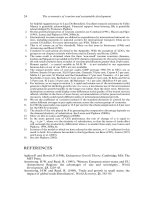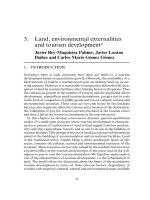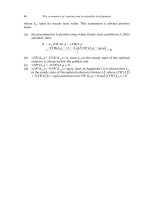THE ECONOMICS OF MONEY,BANKING, AND FINANCIAL MARKETS 497
Bạn đang xem bản rút gọn của tài liệu. Xem và tải ngay bản đầy đủ của tài liệu tại đây (51.38 KB, 1 trang )
CHAPTER 18
GLOBAL
The Conduct of Monetary Policy: Strategy and Tactics
465
The European Central Bank s Monetary Policy Strategy
The European Central Bank (ECB) pursues a
hybrid monetary policy strategy that has elements in common with the monetary-targeting
strategy previously used by the Bundesbank
but also includes some elements of inflation
targeting.* Like inflation targeting, the ECB has
an announced goal for inflation over the
medium term of below, but close to, 2%. The
ECB s strategy has two key pillars. First,
monetary and credit aggregates are assessed
for their implications for future inflation
and economic growth. Second, many other
economic variables are used to assess the
future economic outlook. (Until 2003, the ECB
employed something closer to a monetary
target, setting a reference value for the
growth rate of the M3 monetary aggregate.)
The ECB s strategy is somewhat unclear
and has been subject to criticism for this
reason. Although the below, but close to,
2% goal for inflation sounds like an inflation
target, the ECB has repeatedly stated that it
does not have an inflation target. This central
bank seems to have decided to try to have its
cake and eat it, too by not committing too
strongly to either a monetary-targeting strategy or an inflation-targeting strategy. The
resulting difficulty of assessing the ECB s
strategy has the potential to reduce the
accountability of the institution.
* For a description of the ECB s monetary policy strategy, go to the ECB s website at www.ecb.int.
Germany s central bank, the Bundesbank, chose to focus on a narrow monetary
aggregate called central bank money, the sum of currency in circulation and bank
deposits weighted by the 1974 required reserve ratios. In 1988, the Bundesbank
switched targets from central bank money to M3.
The key fact about the monetary targeting regime in Germany is that it was
not a Friedman-type monetary targeting rule in which a monetary aggregate is
kept on a constant-growth-rate path and is the primary focus of monetary policy. The Bundesbank allowed growth outside of its target ranges for periods of
two to three years, and overshoots of its targets were subsequently reversed.
Monetary targeting in Germany was instead primarily a method of communicating the strategy of monetary policy focused on long-run considerations and the
control of inflation.
The calculation of monetary target ranges puts great stress on making policy
transparent (clear, simple, and understandable) and on regular communication
with the public. First and foremost, a numerical inflation goal was prominently featured in the setting of target ranges. Second, monetary targeting, far from being a
rigid policy rule, was flexible in practice. The target ranges for money growth were
missed about 50% of the time in Germany, often because of the Bundesbank s concern about other objectives, including output and exchange rates. Furthermore,
the Bundesbank demonstrated its flexibility by allowing its inflation goal to vary
over time and to converge gradually to the long-run inflation goal.
The monetary targeting regime in Germany demonstrated a strong commitment
to clear communication of the strategy to the general public. The money growth targets were continually used as a framework to explain the monetary policy strategy,
and the Bundesbank expended tremendous effort in its publications and in frequent
speeches by central bank officials to communicate to the public what the central









